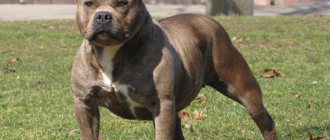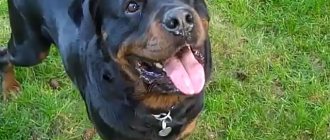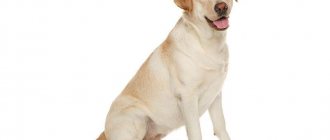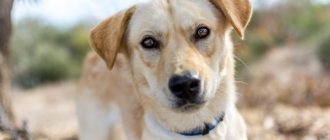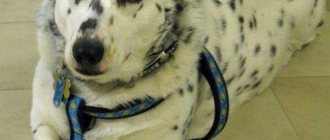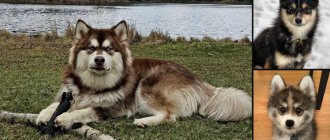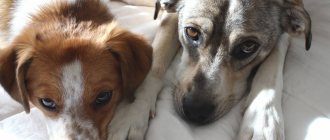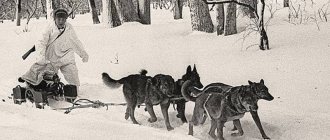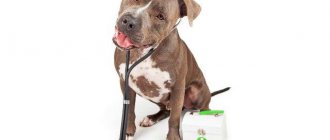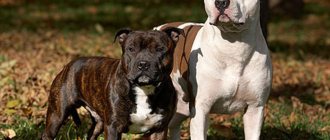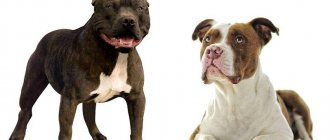There is a lot of controversy about the Pit Bull (American Pit Bull Terrier) dog breed. Some consider her uncontrollable and aggressive, others say she is friendly, affectionate and loyal.
Wanting to eradicate innate zoo aggression, people began to cross pit bulls with other breeds.
Many mestizos have become not only more flexible, but also have a very original appearance.
Types of Pit Bull Terrier Mixes
Not all dog handlers and breeders are positive about the idea of mixing several breeds. In their opinion, the result can be completely unpredictable. After all, there are no guarantees that mestizos will inherit only the good qualities of their parents.
Other experts believe that competent selection can improve the livestock and give the pit bull new properties. For example, make him a protective guard dog. This is indeed true if targeted work is carried out and individuals with anomalies are culled.
For your information. Puppies obtained as a result of random mating, especially with mongrels, may have less than ideal appearance and character. Therefore, only professional breeders should breed dogs.
A few words about the pit bull terrier breed:
- Pit bulls are divided into 3 types. The bulldog type is strong and stocky, the terrier type is dry and lean, the mixed type combines the characteristics of the two types.
- The height at the withers is 46-56 cm.
- Weight is not limited. It usually ranges from 12 to 36 kg.
- The Pit Bull Terrier can be any color.
These dogs are not yet recognized by the FCI. The international organization ADBA is responsible for registering litters. She and the United Kennel Club (UKC) approved the current standards.
Depending on the purposes, animals are crossed with certain breeds. This explains the variety of pit bull crosses. It is worth talking about each of them in more detail.
Breed varieties
The Amstaff Terrier is not only a strong and strong dog, but also an elegant dog. She is brave and obedient if raised correctly.
There are several types of these animals:
- Proportional. This dog fully complies with all stated standards.
- Bulldog-shaped. In appearance it resembles a bulldog. They have a short neck and a body that looks like it has been carved with an axe. Their body weight exceeds 45 kg, so it is difficult for them to move a lot.
- Terrier. This is a fairly mobile and light dog, weighing no more than 30 kg. Her mouth is slightly elongated and her neck is long.
Important! For home keeping, it is preferable to choose puppies of proportional appearance. But they are very difficult to find, as they are very rare.
The breed standard is:
- The head is wide and voluminous. The skull is square with an unpronounced occipital protuberance and a sharp transition from the forehead.
- The ears are high and widely spaced. Most often they are docked.
- The eyes are small, widely spaced and round. The pupils are dark in color.
- Eyelids with colored pigmentation (no pink tint).
- The nose is large, with wide nostrils and a black lobe on top.
- The jaws are powerful, with a prominent scissor bite.
- The teeth are large and white.
- The neck is not too long, with strong muscles and thick, non-sagging skin.
- The withers are muscular, smoothly transitioning to a short and straight back.
- The chest is prominent, with a clearly visible line of ribs.
- The tail is set low and short. It is slightly narrowed towards the tip. When alarmed, the animal raises it.
- The coat is short but thick. In a healthy dog it is hard and shiny.
- The limbs are straight and muscular. The front ones are widely spaced, their size is slightly larger than the rear ones.
Despite their power, the staffs move springily. If a dog ambles, then this is a breed defect.
The color can be jet black, white, blue, brindle, fawn and “boar”. According to the FCI requirements, solid colors are acceptable, but white should not cover more than 80 percent of the animal's body.
Husky and pitbull
The mix of husky and pit bull was called Pitsky. Mestizos turn out to be quite tall - from 50 to 55 cm at the withers. However, they are light-boned and graceful in build.
The ears usually stand high on the head, but most owners prefer to crop them in early childhood.
The pigmentation of the iris can be anything - brown, ocher, blue. Crossbreeds with heterochromia (different eye colors) are often found.
The coat is short or medium length. It can also come in different shades. The face usually has a light mask, like a husky. The lower part of the body is often lightened.
Pitskis are friendly, active, hardy and sociable. At the same time, they are stubborn; many crossbreeds have a pronounced hunting instinct.
Mixed pit bulls do not get along well with their relatives. And if husky blood predominates in their veins, then they have a tendency to run away, dig tunnels and pick up everything they see on the street.
What other dog breeds are on the “dangerous list” along with pit bull mastiffs?
From January 1, 2022, the Federal Law “On the Responsible Treatment of Animals and on Amendments to Certain Legislative Acts of the Russian Federation” dated December 27, 2018 N 498-FZ comes into full force. According to this legislative act (Article 13, paragraph 6), dogs included in the “List of Potentially Dangerous Breeds” must be walked only with a muzzle and on a leash. The only place where you do not need to adhere to this rule is the territory belonging to the dog’s owner. This area should be fenced with a solid fence, and at the entrance there should be a sign “Beware, angry dog!”
A total of twelve dog breeds are included in this list; the thirteenth item includes mixed breeds of the above breeds. The Pit Bull Mastiff is in eleventh position on this list.
List of potentially dangerous dogs:
- Akbash.
- American Bandog.
- Ambuldog.
- Brazilian Bulldog.
- Bully Kutta.
- Purebred Alapaha Bulldog (Otto).
- Bandog.
- Wolf-dog hybrids.
- Wolfdog, wolf hybrid.
- Gul dong.
- Pitbull mastiff.
- North Caucasian dog.
- Mixed dogs from points 1-12.
Representatives of the RKF have a number of questions for legislators; not all breeds actually exist, not all are found in our country, but the rules are the rules. Owners of Pitbull Mastiff mixes will need to comply. Violation of this Law provides for liability.
Staffordshire Terrier and Pitbull
A cross between a Staffy and a Pitbull, it is a medium-sized dog with a height of 43-49 cm and a weight of 15-30 kg. In the exterior, the characteristics of one breed predominate, or the traits of both are equally manifested.
On a note. Since the Stafford is a close relative of the pit bull, unscrupulous breeders often pass off mestizos as purebreds.
This crossbreed does not show aggression towards people, but it is characterized by stubbornness and intolerance towards other four-legged animals.
Staffordshire Terrier and Pit Bull mixes require strict education and training. Only with this approach can you get a balanced dog that can live in a family with children.
Stages of development by month
As already mentioned, a newborn pit bull cannot see or hear, but it does have a developed sense of smell. During the first month of life, around the 10th to 14th day, the puppy's eyes and ears open.
By the end of the fourth week, most babies are ready to try solid foods and can actively play with each other.
Important! The normal weight for pit bulls at this age is considered to be 2.5–4 kilograms, and the average body length can be 20–25 centimeters.
2 months is the age at which socialization begins, when puppies are weaned from their mother. During this period, they already have a stronger physique, weigh from 6 to 9 kilograms, and their body length reaches 30 centimeters. By the end of the second month, the babies can already find owners.
3 months is the period when a purebred pit bull begins to acquire the standard appearance of the breed. The puppy's teeth change, the musculoskeletal system strengthens, and weight increases. At three months, a pit bull can weigh up to 14 kilograms and have a body length of 30–36 centimeters.
At 4 months, the puppy recognizes and recognizes its new owner, and the mental component of the dog’s personality begins to form.
At the age of 5 months, the replacement of baby teeth with molars will be completed.
The pit bull is actively developing during this period; the puppy’s weight can reach 24 kilograms and its body length is 45 centimeters.
6 months - the puppy enters adolescence and begins to understand what kind of hierarchy is established in the house. It must be shown that the dog does not play a dominant role in the family and must obey the owner. The puppy's character will emerge and he will begin to be stubborn, so it is important to quickly “put him in his place.” At this age, a young pit bull weighs up to 28 kilograms and has a body up to 48 centimeters long.
At 7 months, an ill-mannered puppy tries even more persistently to take the highest place in the home hierarchy; during this same period, puberty occurs - girls begin to go into heat, male pit bulls can show aggression or begin to “sit” on pieces of furniture, toys, legs and hands of the owners.
At 8 months, the dog will develop and strengthen those character traits that it will retain throughout its life. At this age, the puppy already looks like an adult pit bull; it can weigh up to 35 kilograms with a body length of 48–50 centimeters.
The final period of a puppy’s maturation is the 9th–12th months. The American Pit Bull Terrier is already acquiring a characteristic exterior, has a formed body and established character traits. If the owner was unable to teach the growing pit bull manners by this age, then in the future the dog will be less amenable to training, and an inexperienced owner may not be able to cope without the help of specialists.
This is interesting! By the age of one year, the pit bull stops body growth and weight gain, but it is believed that the exterior is fully formed only by two or three years.
Rottweiler and pitbull
The Pitweiler is a cross between a Rottweiler and a Pitbull. This is a large dog weighing up to 40 kg with a massive body and wide chest.
The head is large, proportional to the body, with developed cheekbones and pronounced stops. The ears are moderate in size and have a “rose” shape. The jaws are strong, but not as wide as those of Rottweilers.
The body of the animal is covered with short and shiny hair. The most common colors are black and brown with tan and white markings.
Properly raised and socialized crossbreeds grow up obedient and loyal. They are fearless and wary of strangers, so they can be used for protection. However, mestizos often conflict with their relatives and do not get along well with other pets.
For your information. This crossbreed tends to be dominant. It must be led by a person of strong character.
Métis health
All large dogs live less than miniature ones. Pit bull and mastiff mixes are large in size - their average life expectancy is 8-12 years. Some genetic and non-hereditary health problems present in this breed may affect this duration.
- Hip dysplasia.
- Diabetes.
- Hypothyroidism.
- Subaortic stenosis.
- Progressive retinal atrophy.
- Chronic renal failure.
Labrador and pit bull
A cross between a Labrador and a pit bull, or Labrabull, the Labrador is an intelligent, loyal and active dog. The animals grow quite large, but have light bones.
Mestizos have ears that are completely hanging or raised on cartilage, a cone-shaped head, and a kind and attentive look. The body is covered with short and thick fur.
This pit bull mix can be any color acceptable for both breeds. The most common:
There are white markings on the body.
The character of animals is usually dominated by the traits of Labradors - kindness, openness, devotion, sociability.
Labraboulls are rarely stubborn and never refuse to play. Thanks to these qualities, they have become popular all over the world.
Vaccination
Vaccinations are given to pit bulls throughout their life, starting at 8–10 weeks. The first vaccination at this age is a comprehensive vaccination against distemper, hepatitis, adenovirus infection, parainfluenza, parovirus enteritis and leptospirosis.
At 12 weeks, a second vaccination is given. At six months the puppy is vaccinated against rabies, and after another six months all vaccinations are repeated.
After this, they go to the veterinarian annually for revaccination against all the diseases mentioned.
Doberman and pitbull
Dober Pit is a cross between a Doberman and a pit bull. Metis can have both medium and high height (65-70 cm).
The physique is similar to a Doberman: long limbs, muscular, but not overly massive body. But the head looks more like a pit bull:
- high-set, semi-erect ears (can be cropped);
- developed cheekbones;
- powerful jaws.
Short wool can be of any color. Often there are crosses with the tan markings characteristic of Doberman Pinschers.
There is an innate distrust of strangers in the character. Zoo aggression is not excluded - it is inherent in both breeds.
Hygiene
You don't need to bathe your pit bull puppy often. Exceptions are cases when he gets dirty in the mud or swims in a puddle. If the puppy is white, or just light-colored, it will be more noticeable when it's time for a bath.
When it comes to bath procedures, certain rules are followed:
water temperature not higher than 38°C;
During and after bathing, make sure that the puppy is not exposed to a draft.
To maintain oral hygiene, you need to properly care for your teeth - for this you use a special paste and a brush, similar to a human one, or one that is put on your finger. The dog is gradually accustomed to this procedure, always starting with the far teeth on the outside.
The puppy's eyes should always be clean. If discharge appears, the eyes are washed or treated with special medications. If the discharge is permanent, consult a doctor.
Ears are cleaned every week. To do this, use a cotton swab and ear cleaner. It is important to regularly check your dog for ticks - they like to “cling” closer to the ears, jaw and neck.
Important! Under no circumstances should you use saline solutions or products containing alcohol to clean your ears.
Dachshund and pitbull
The amazing combination of Dachshund and Pit Bull is a short-legged but very muscular dog with a massive head. Her body is covered with short hair, which does not protect well from the cold.
These animals prefer to spend time close to their owners.
If you cross a pit bull with a dachshund, you will get a cheerful, friendly, playful dog. She gets along with other pets if she grows up with them in the same territory since childhood. However, there are some drawbacks - these crossbreeds are characterized by stubbornness and a hunting instinct.
Useful video
The video talks about a pit bull mix:
12 minutes to read
Pit bull mastiffs are dogs that have an undeservedly bad reputation. People are afraid of these animals, consider them unreasonably aggressive and very dangerous. The descendants of these dogs have fighting roots - this served to create the stereotype of uncontrollable bloodthirsty pets.
Interest in this type of dog has recently grown due to the fact that pit bull mastiffs are included by legislators in the “List of Potentially Dangerous Dog Breeds.” These dogs must be on a leash and muzzle when appearing in public places, and their presence on the territory of a private home must be indicated by a warning sign.
What exactly is a Pitbull Mastiff dog? Does such a breed exist? What types of pit bull terriers and mastiffs can you find? What do these controversial animals look like and are they characterized? You can find answers to all these and other questions about this type of dog in our material.
Alabai and pit bull
A cross between an Alabai and a pit bull grows slightly smaller than a Central Asian Shepherd Dog. The body of the animals is covered with dense wool, thanks to which the mestizos tolerate the cold quite well.
The color can be any:
- white;
- red;
- gray;
- fawn;
- spotted;
- brindle.
These are strong, hardy and efficient dogs with good guard potential. In order for a dog to grow up balanced and adequate, early socialization and competent training are necessary.
Shepherd and pitbull
The cross with a shepherd is called the German Pit. Mixed breeds turn out to be quite large - about 60 cm at the withers and weighing 30-35 kg.
These dogs have a slender and fit body, well-developed muscles, and long legs. The head is compact, the ears are erect, V-shaped, but the ear tissue is thinner than that of German Shepherds.
The coat is a cross between the fur of a German and a pit bull. Any color is acceptable, including light markings and tan. Brindle-colored dogs look especially impressive.
The crossbreeds have the predominant character of German Shepherds - brave, noble and decisive. Dogs are loyal to their owners, get along well with children and are wary of strangers.
As a rule, they have a sharp mind and are highly trainable. In adolescence, mestizos try to dominate. To prevent the dog from taking a dominant position, the owner must behave strictly and adamantly.
For your information. When training a German pit dog, you cannot use brute physical force and deliberately develop aggression towards people in him. Because of this, the dog's character will change for the worse.
Differences in Personality
Amstaffs and pit bull terriers have gained fame as merciless killers. The explanation lies in the original purpose - the breeds were bred for fighting. Particular cruelty is attributed to pit bulls. They are still banned in some European countries and US states, and their content is subject to strict rules and prohibitions.
Today both breeds are companion dogs. They are affectionate, playful and endlessly devoted to their owner. However, only an experienced owner can handle them.
The reputation of aggressive dogs is partly supported by their owners. They unintentionally, due to lack of experience, or deliberately develop cruelty in their pets. As a result, animals grow up uncontrollable.
The standard attributes confidence to both breeds. Cowardice or unreasonable aggression is not allowed.
When deciding who to choose, an Amstaff or a pit bull, take into account the following nuances:
- Staffordshire Terriers are more flexible, they remember commands more easily and are more willing to carry them out;
- It is believed that the level of aggression in pit bulls is higher;
- both breeds are among the smartest, but Staffs are more diligent “students”, as they try to please the owner;
- Contrary to popular belief, both dogs cannot be used for guarding, they are only suitable for protection.
Pit bull and bull terrier
Pit bulls and bull terriers belong to the terrier group, but there are significant differences between these breeds. The latter are dense and stocky animals with an ovoid head and a drooping muzzle. Their ancestors were Dalmatians, Old English and English bulldogs. The differences are very clearly visible if you put the dogs side by side.
Pit bulls also have the blood of English bulldogs, but they are mixed with some other terriers. What exactly remains a mystery. This is the reason for the differences in appearance.
Pit bull and bull terrier are fighting species that previously participated in dog fights. However, with proper upbringing, they make loyal companions.
The same can be said about crossbreeds. They grow stockier than pit bulls, but the shape of their heads no longer resembles bull terriers.
A pit bull crossed with a bull terrier is fearless, disciplined, cheerful and stubborn. People with leadership abilities should get such a dog, otherwise it will grow up uncontrollable.
Drawing conclusions
Now you know how to distinguish a pit bull from a staff dog, why these dogs are so similar and what to look for when choosing them. Each of them has its own pros and cons. The main thing you must understand is that these are not just beautiful and strong dogs, these are pets for whose actions you take responsibility. They require serious and professional training, attention and significant physical activity. Otherwise, you may end up with an uncontrollable animal. These terriers are not suitable for novice dog owners; you must have enough knowledge and self-confidence.
